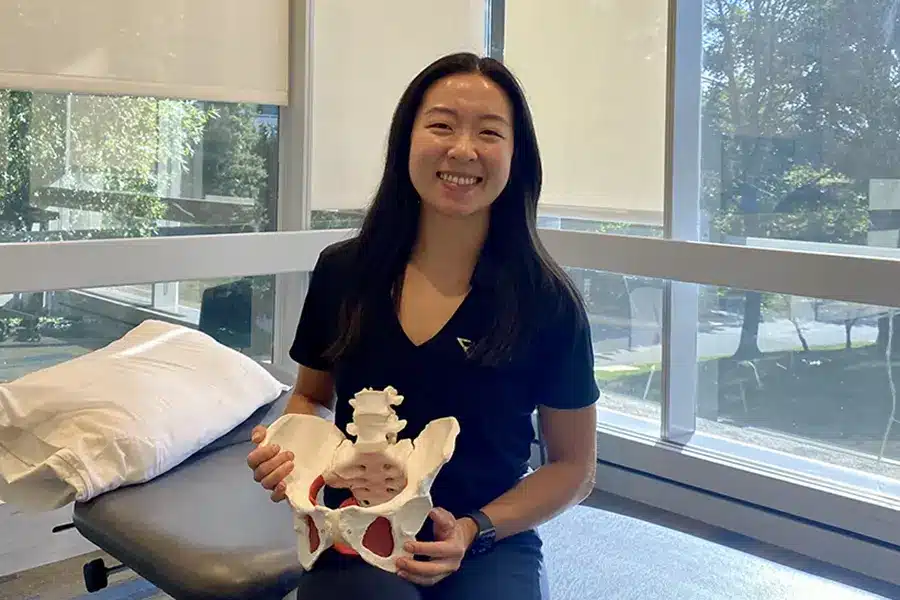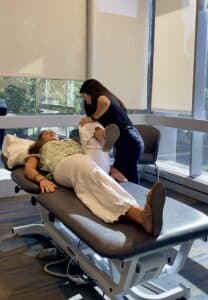
Strengthen Your Spine with Pelvic Floor Therapy
Are you struggling with chronic pain or mobility issues that haven’t responded to traditional treatments? Pelvic floor therapy might be the key to unlocking relief and restoring your quality of life. This specialized therapy can tackle a range of bodily issues, including chronic back pain and nerve-related pain. Many patients are surprised to learn about the critical connection between pelvic floor health and spine stability; and recognizing this connection could be an essential step toward finding lasting relief.
What is Pelvic Floor Therapy?
Pelvic floor therapy (PFT) is a specialized physical therapy approach that helps both relax and strengthen the muscles surrounding one’s pelvic floor. The pelvic floor is the group of muscles and connective tissue that support the bladder, rectum, and uterus (for women). These muscles are vitally important for the control of your urinary and sexual functions, as well as childbirth. Pelvic floor dysfunction can occur if these pelvic muscles aren’t functioning properly, and can result in leaking/incontinence, constipation, and pain. Since pelvic floor dysfunction can also be masked as other conditions, a comprehensive evaluation to find the primary source of your symptoms is extremely important.
Benefits of Pelvic Floor Therapy
Most of us don’t fully appreciate good pelvic floor function until it’s compromised. It can be extremely frustrating to experience the symptoms that come with pelvic floor dysfunction, such as simply losing the ability to control your bladder. PFT helps people maintain a healthy pelvic floor so they can control their bodily functions. Some other benefits to a healthy pelvic floor are improved overall stability, flexibility, and mobility. PFT is especially important for pregnant women, as strengthening these muscles will help them safely deliver their baby and recover faster postpartum. PFT is also important for athletes and spine patients in order to ensure global stability.
The Connection Between Your Spine and Pelvic Floor
The pelvic floor is a vital component of the human anatomy that plays a major role in general health and wellbeing. Pelvic floor dysfunction is the inability to properly use one’s pelvic floor muscles, which often results in urinary issues, bowel problems, and pain. It can be brought on by many sources, including aging, childbirth, persistent constipation, and surgery. It is frequently advised to undergo pelvic floor therapy to address these problems and enhance pelvic floor function.
Your spine has a great impact on almost every aspect of your health as the literal backbone of your body and the maintainer of your nervous system. It only makes sense that many conditions involving your spine also are impacted by your pelvic floor, and vice versa. In fact, the pelvic floor muscles attach your tailbone to your pubic bone. Both of these bodily functionalities are crucial for your overall health and stability, for both male and female patients.
Pelvic floor dysfunction can also be masked as other conditions, such as low back or hip pain. With every patient, it is extremely important to have a holistic and comprehensive approach to spine treatment. At VSI, we have a team of skilled surgeons, nonoperative specialists, and physical therapists who work together to provide the best possible treatment for each patient.
Spine Conditions that Benefit from Pelvic Floor Therapy
Several spinal conditions greatly benefit from pelvic floor therapy. One of our nonoperative doctors, Dr. Niteesh Bharara, recommends several of his patients to get PFT. Some particular spinal conditions that see results from this form of therapy are sacroiliitis, radiculopathy, lumbar, pelvic, or hip instability, and neuralgia.
The Sacroiliac (SI) Joint is where the spine meets the pelvis. When this joint becomes inflamed and causes pain, it is referred to as sacroiliitis. This condition may result in shooting pain or numbness and tingling down your legs. This condition may also present itself as loss of bladder control, which is exactly where PTF comes in. Radiculopathy is an irritation of nerve roots, which is commonly referred to as a “pinched nerve.” If the pinched nerve is located near the bottom of the spine, PFT helps soothe and stretch these muscles to ease the pain.
Lumbar, pelvic, and hip instability is commonly associated with plenty of spinal conditions and naturally occurs with age. PFT directly works to stabilize these areas so they can better function. Neuralgia is shooting pain associated with nerve damage or pressure and also is greatly relieved by a healthy pelvic floor since this takes pressure off the spine. Finally, PFT helps relieve pain associated with spine surgery recovery since a healthy spine always needs to be supported by a strong core and healthy pelvic floor.
When treating any condition, it is extremely important to look holistically at the patient and their bodily functions. What affects one part of the body has an impact on every other part of the body. Having access to VSI’s multidisciplinary practice will ensure that you will be thoroughly examined and that every approach will be considered. Ask your doctor if PFT could be beneficial for your spine condition and schedule a consultation today with our PFT specialist Sheri Jean at VSI Physical Therapy.
What to Expect in a Pelvic Floor Therapy Session

What to expect in a pelvic floor therapy session really depends on what the person is coming in for. If a patient’s primary issue is incontinence, the focus would be on pelvic floor strengthening; depending on how severe the person’s incontinence is, the session could consist of being on a table teaching the patient how to properly contract their pelvic floor. On the other hand, we could be in the gym working on higher functional movements and incorporating the pelvic floor. If a patient’s primary issue is pelvic pain, a session may start with some manual therapy for the pelvic floor or surrounding musculature, and potentially working on relaxation techniques for the pelvic floor. At the end of the day, every patient is going to be put on some sort of strengthening program to ensure that their pelvic floor has the capacity to support them throughout all their activities.
Topics covered
About the Author
Featured Resources
Insights to Achieve a Pain-Free Life



